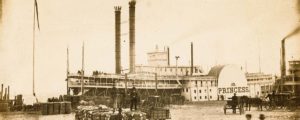After escaping the Tombstone fight, Ike didn’t exactly mend his ways.
Newman Haynes “Old Man” Clanton arrived in Arizona Territory in 1873 with three sons—Phineas (“Phin,” the eldest), Joseph Isaac (“Ike”) and youngster William (“Billy”). Old Man Clanton, a widower, had plans to corner the lucrative cattle market, which supplied several forts and reservations. After he settled in, his plan got a boost from a big silver strike. Tombstone and accompanying mill towns emerged overnight. The Clanton clan had several ranches, strategically placed so as to avoid scrutiny—the reason being that many of their cattle were rustled from Mexico. The Clantons found kindred spirits in a loosely tied group of undesirables known as the Cowboys. Since there was little organized law south of Tucson, the boys had little trouble with their illegal herds. They might have had less future trouble were it not for Ike.
Ike, born in 1847, garnered a reputation in Cochise County as a loudmouthed braggart and heavy drinker—a bad combination. In her memoirs Josie Marcus Earp, the widow of Wyatt, remarked that Ike was uncivil, unkempt and chewed with his mouth open. Young Billy was sizable for a teenager and had a taste for the saloons like his brother. Phin mostly tended to ranching activities with their cattle—or someone else’s.
By 1880 Tombstone and the surrounding area had experienced a population surge. Miners, merchants, gamblers and Cowboys intermingled in the roaring silver camp. Ike was ever present and often an instigator. The absence of the law, however, was about to change, and Ike and friends were slow to grasp it. The Earps had come to town. In June 1881 Chief of Police Virgil Earp separated Ike and another drunk before they could exchange gunfire. That summer Old Man Clanton and five other drovers were fatally ambushed down near the border by a Mexican contingency that had tired of gringo thieves. On the evening of October 25 Ike and Doc Holliday came close to a fight, the result of a festering feud between the Cowboys and the Earp group.
The next day, October 26, made Western history and forever linked the Clantons and the Earps and the misnamed Gunfight at the OK Corral. Ike’s threats were, to that point, empty. When he blustered that morning about wanting a fight, Virgil and Morgan Earp offered him the chance. Ike demurred. Later that afternoon Ike would play out his best (or worst) performance. Virgil, Wyatt and Morgan Earp and Doc Holliday resolutely marched down Fremont Street and confronted their adversaries—Ike and Billy Clanton, Frank and Tom McLaury, and Billy Claiborne (who fled early). After the opening shots in a vacant lot, an unarmed Ike grabbed Wyatt by the arm, pleading for mercy. One version has Wyatt adhering to the “Code of the West” and allowing Ike to flee. This author believes Wyatt was thrown off balance by Ike’s lunge and unable to gun down the scurrying troublemaker. In any case, Ike’s flight ended within the safe environs of John Lucas’ law office on Toughnut Street, far from the shootout that cost his younger brother, Billy, and the McLaury brothers their lives. The casualties of the Tombstone gunfight would not be the last to pay a steep price for Ike’s behavior.
Ike twice filed charges against the Earps and Holliday, and twice they were exonerated. Ike then turned to another venue. In December he and cohorts ambushed and crippled Virgil. In March 1882 gunmen assassinated Morgan Earp, which prompted Wyatt’s well-chronicled vengeance ride. His first target was Frank Stilwell. He and Ike were lurking about the train yards in Tucson, looking for a shot at the Earp party that was seeing off the wounded Virgil to safety in California. Friends tipped off Wyatt, who went hunting for Stilwell and Ike. Luck was with Ike again, as he managed to slink away. Stilwell ended up shot to pieces and left beside the tracks. One observer commented, “He was the most shot up man I ever saw.”
Wyatt and posse continued their rampage through southern Arizona Territory, seeking and killing Cowboys. Ike remained in hiding, his whereabouts unknown. But after the Earp party vacated Arizona, Ike and Phin resurfaced in Springerville, 175 miles north of Tombstone near the New Mexico Territory border. There they reunited with sister Mary. The boys reverted back to form and were soon making a bad name for themselves in Apache County. Among Ike’s recruits was Eben Stanley, Mary’s husband. Eben had earned the Medal of Honor while serving with the 5th U.S. Cavalry in Indian campaigns. Ike managed to lure him to the dark side. Phin and Eben were indicted for cattle theft. But the law somehow missed Ike yet again.
In December 1885 masked men reportedly forced an Apache County official to open a safe and made off with more than $11,000. The victim identified Ike, Phin, Eben and pal Lee Renfro. No legal action was taken, as the official himself was later convicted of embezzling the money. In May 1886 Ike shot Pablo Romero over a card game in a Springerville saloon. Ike fled to Jonas “Rawhide Jake” Brighton’s house for refuge. Although lawmen arrested Ike a few days later, a judge dismissed the charges for insufficient evidence. In November 1886 Ike was present when Renfro killed Isaac Ellinger. That was the last straw for Apache County Sheriff Commodore Perry Owens.
The flamboyant Owens dispatched Rawhide Jake Brighton—the same man who had sheltered the fugitive Ike after the Romero shooting—to clean out the Clantons. Phin was indicted for rustling and arrested. Ike remained elusive. On June 1, 1887, while trailing their prey, Brighton and a deputy were breakfasting at a cabin on Eagle Creek, south of Springerville, when fate entered. Ike Clanton rode up to the cabin and engaged his former friend in conversation. When another face appeared in the cabin doorway, Ike smelled a rat. He wheeled his horse, and two shots rang out. Ike dropped from his mount, dead.
Brighton later claimed Ike had reached for his rifle. But Clanton’s inclination was to vamoose from trouble. Perhaps Brighton was carrying out orders to “make things right,” by any means. He finished Lee Renfro off in like manner. Eben Stanley wisely packed off to New Mexico Territory. He died in 1904 and is buried in Hillsboro, N.M. Ike Clanton’s grave remains undiscovered.
Phin Clanton managed to accomplish what his father and brothers could not. He died with his boots off. After serving time at the Yuma Territorial Prison, he won a pardon and went to Globe. In 1894 he was arrested for armed robbery but acquitted. In 1902 he married Laura Jane Bound. She led her own full life, having married at least seven times. Ironically after Phin died, in 1906, Jane married Pete Spence, former Tombstone badman and ex-con. When Pete died, Jane buried him beside Phin, in the Globe Cemetery, without benefit of a marker.
Author and noted Earp expert Bob Palmquist shared a take on the Clanton legacy, as told by the late Glenn Boyer: “Savvy visitors to his [Phin’s] grave might mention sighting a calf that passed by and then may see him rear out of the ground, branding iron in hand, yelling, ‘Whichaway did he go?’”
Originally published in the October 2013 issue of Wild West. To subscribe, click here.




